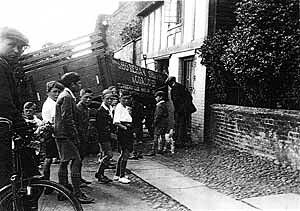Steyning Museum - Hazards of the Road
From the Steyning Museum archivesHazards of the Road.

In 1770 a post boy was robbed of his mail bags between Arundel and Steyning "by a tall thin man wearing a dirty round frock" [a 'round frock' was a smock]. This was at a time when many untended tracks were being converted into cared for turnpike roads. When the Horsham to Steyning route through Partridge Green was proposed as a turnpike in the 1760's it would have acquired the right to charge tolls to pay for its maintenance. Steyning people took a particular interest in that.
Richard Penfold did not like the idea of tolls being levied at Bines Green in addition to those at Wappingthorne on the approaches to Steyning. He pointed out that the people of Steyning carried considerable amounts of "wood and faggots" [i.e. firewood] down the Ashurst Road from the West Grinstead area and should not be expected to "be burthened with that additional toll". He then added, "we likewise would wish to have leave to remove the Market House to any commodious place of the town that the major part of the inhabitants shall think proper". The market house at that time sat in the middle of the High Street outside the post office and would have been a serious impediment to coaches travelling to Worthing or Brighton and, as we know, it was indeed moved - but the Bines toll gate was established despite Richard Penfold's protest.
A traveller on the newly constructed road commented on how flat and even the surface was. However it must still have been muddy in winter with clouds of dust during dry weather. Mrs. Carew recalled that in the early days of motoring "the veils worn by ladies... were most necessary to protect their hats and hair. They also had to wear a light dustcoat if they wished to arrive at their destination fit to be seen".
Writing of her childhood in the 1880's Mrs. Carew said that "A good many farm workers still rode the old penny farthing bicycle to work. I little thought that a few years later I should have the first ladies bicycle in Steyning. I could only ride it through the street when my father rode with me and, even then, all the naughty little boys shouted rude remarks at me." She must have been 5 or 6 when she walked down to see the toll gate at Bramber on its last day of operation. It does not seem to have been particularly exciting. "There was hardly any traffic then although it was on a main road to Brighton, and we had to wait a long time to see anything go through. At last a dog cart came along, they paid their toll and the gate was opened."
Another reminiscence refers to "New Roads" being built in 1883 "taking the cricket field and other fields to build on". This is a reference to College Hill - which cut through the old cricket field at the top of the rise - and Goring Road.
Roads were evolving in response to a growing population and to the arrival of bicycles and the motor car, but motor vehicles were themselves unreliable. A newspaper report of 1908 tells of a vehicle setting out from Bognor Regis full of footballers eager to play a match against Steyning. "The first 'halt'" it says "was in the Felpham Road, about a mile from the start. After twenty minutes wait they proceeded as far as Yapton where there was another halt - more repairs. The automobile again caused trouble about half a mile further along the road near Ford Junction and after yet another stop they did not reach Arundel until 4.00. Here they sent a telegram to their opponents declaring the visit off - and then returned to Bognor."
The hazards of travel might have changed between 1770 and 1908 but it was still not easy to get around the roads of Sussex.

